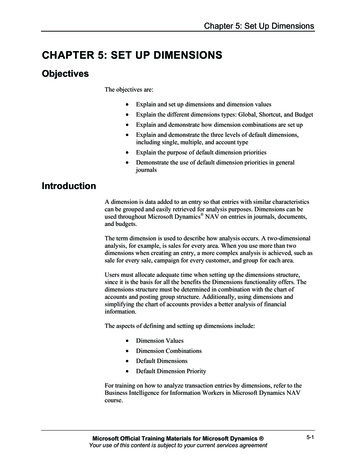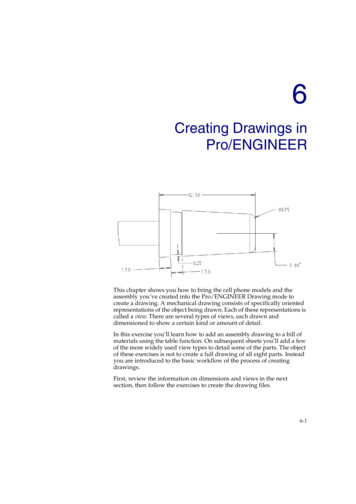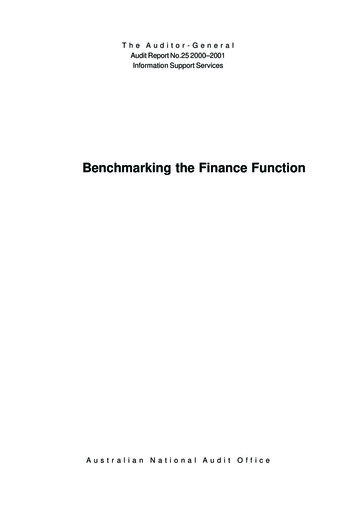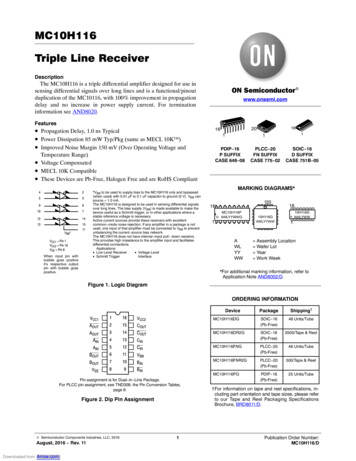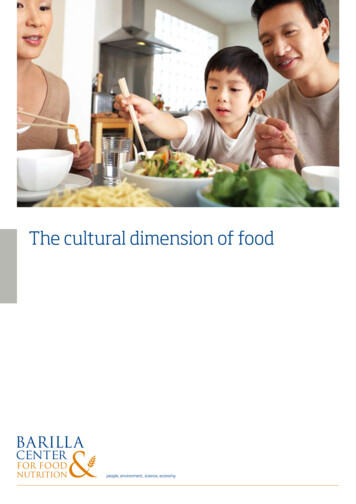
Transcription
The cultural dimension of food
The cultural dimension of foodEXECUTIVE SUMMARY1.The cultural dimension of food1.1 Food—marriage of nature and culture1.2 Food as a stimulus to primordial communication1.3 What is food and what isn’t: cultural classification of what is edible1.4 Food, culture and social power2. THE FOOD-CULTURE RELATIONSHIP IN THE PRACTICE, SPIRITUAL AND SOCIAL LIFE2.1 Food in the world’s great religions2.1.1 Food, knowledge and sin2.1.2 Food sharing and congregation of the faithful2.1.3 Dietary prohibition: food and purity2.2 The world’s great culinary traditions2.2.1 Mediterranean cuisine2.2.2 Oriental cuisine2.2.3 Anglo-Saxon cuisine2.2.4 Dietary crossovers2.3 Diet and social rituals2.3.1 Food as a shared pleasure2.3.2 Table rituals2.3.3 The competence and cuisine knowledge to strenght social identity2.4 Recent history of man’s relationship with food2.4.1 From the post-war period to the 1970s: birth of the modern food industry2.4.2 ‘80s-‘90s: globalization, fast hedonism and slow philosophy2.4.3 Today: the shopping trolley full of wealth or threats2.5 The impoverishment of the food-culture relationship2.5.1 Cooking, the table and food: the how, where and what of eating2.5.2 Food as experience3. THE INFLUENCE OF SOCIAL CULTURAL TREND ON CONTEMPORARY NUTRITION3.1 The omnivore’s dilemma in today’s world3.1.1 Past dietary traditions: good to eat and good to think3.2 Rediscovery of naturality3.2.1 Orientation to authenticity3.2.2 The vegetarian approach3.2.3 Food, environment and sustainability3.2.4 New responsibilities for industry3.2.5 Food advertising: myth-making, brands and manipulation3.2.6 For a new vision: going back to the central dimension of food, redefining the pleasureand spread knowledge of 324252526272829304. CONCLUSIONConclusion31BIBLIOGRAPHY333
Executive SummaryFrom earliest times, man—like every other species onthe planet—has interacted with nature according toone overriding imperative: survival. For a very longtime, this imperative was based not only on the needto protect himself from what, at times, were highly adverseenvironmental conditions, but above all, on his ability to winthe challenge of eating or being eaten.Continuously exposed to the threat of becoming foodthemselves, our ancestors developed an increasinglysophisticated approach to nature, long before the adventof agriculture approximately 15,000 years ago. The majorphases in this process are well known. In the Paleolithic Age,man had already discovered and begun to use fire. During thesame period, he began to invent numerous tools—first in stoneand later in metal—for hunting, fishing, defense and buildingshelter.Whether gathering fruit from a tree or killing his prey, man’srelationship with the environment around him has alwaysbeen based on transforming it.As mentioned, the discovery of fire marked a major step inman’s ability to manipulate nature. Used alternately for heat,light, protection from wild beasts, send messages and dryclothing, fire made possible progressive cultural developmentsthat were enormously important, especially in terms of diet.For Levi Strauss, cooking food using fire is “the inventionwhich made human beings human”. Before learning aboutcooking, food (and especially meat) was eaten raw, spoiled orrotten. The use of fire brought about a decisive change.Cooking symbolically marks a transition from nature toculture, and also from nature to society, given that while rawis natural in origin, cooked implies a step that is both culturaland social.From that point on, food as such becomes the basis forextraordinary developments in the social and cultural nature ofhuman beings. As Rozin states, national cuisines incarnate thedietary wisdom of populations and their respective cultures.We can therefore say that the history of man’s relationshipwith food has been an extraordinary social and cultural epic,a probing search for significance. What was once perhaps themost difficult aspect of human existence (the search for foodto nourish himself) changed from critical factor to opportunity.4Focusing on this fundamental consideration, thisdocument reviews the most important steps in the concretetransformation and reflections that have accompanied thedevelopment of the man-food relationship.Among the many topics that could conveniently havebeen explored, the choice was made to concentrate on aview that highlights, above all, the cultural importance offood in the religious dimension, in that of convivialityand in identification within the great culinary traditions(Mediterranean, Oriental, Anglo-Saxon), emphasizing, in morerecent times, the gradual loss of content of the food-culturerelationship.At a certain point in history, food ceases to be heedlesspleasure: other considerations start to creep in, such as theincreasing demand of functionality, health worries becomethe modern problems that Pollan has brilliantly defined “theomnivore’s dilemma” – referring to the typical difficultyof human beings, as omnivorous creatures, to define thecomposition of their diet.This brings us to the present when the increasing demandfor authenticity arises and is linked to the rediscovery ofsustainability in all its forms (environment, health, socialrelations) that calls the food industry to account, demandingthat it accept new responsibilities.This is the turning point. What we have today, in the fieldof food styles, is the opportunity to rethink, according to newviewpoints, our entire relationship with food. According toBauman’s analysis, the emerging traits of this new approachcould be situated between the pleasure of the sensoryexperience and the demand for situational conveniencethat allows for full enjoyment of the food consumed. Speed,that has become one of the characterizing elements of ourtime, will certainly affect our relationship with food, in verydifferent ways from those we already know (and that are theexpression of a tragic loss of cultural content).And this introduces two other significant dimensions: fromthe need of more simplified food preparation (making it possibleto gain time lacking today and compensate for the loss of foodculture that makes it impossible to operate independently inthis area); to that of portability – anywhere and everywhere –viewed as ease in enjoying the desired eating style, even in anincreasingly hectic world.
The cultural dimension of foodRitual is also an aspect impacting on our relationship withfood. Regaining ritual aspects will provide the dimension ofsense and reassurance that contributes to making the eatingexperience more intense.In the light of these considerations relative to the culturalimplications of food, we believe in the long run that to addressthe future of food anew means:n valorizing the rich and varied aspect of conviviality;n protecting local territorial variety, with a view toexpansion;n transferring knowledge and know-how as extraordinaryfunds of cultural wealth;n returning to a healthy relationship with the territory andthe context of raw materials, aiming toward the excellenceof the ingredients;n rediscovering the value of food as a means to achieving afertile relationship across the generations, in the simplicityand clarity of its benefits;n recovering ancient flavors, which can be renewed in ourmodern taste;n spreading the culture of taste and the art of good livingthrough authentic food.5
1. The cultural dimension of food1.1 Food—marriage of nature and cultureFrom earliest times, man—like every other species on theplanet—has interacted with nature according to one overridingimperative: survival. For a very long time, this imperative wasbased not only on the need to protect himself from what, attimes, were highly adverse environmental conditions, butabove all, on his ability to win the challenge of eating or beingeaten. The modern-day film industry has often allowed us toexperience the anxiety of these primordial times. Wanderingin search of food since the dawn of time, man has placed hissurvival in two practical principles: the gathering of anythingedible and hunting. According to a leading human ethologist,“man has lived as a hunter-gatherer for 99 percent of his history,and this may also have shaped him biologically”1. Whethergathering fruit from a tree or killing his prey, man’s relationshipwith the environment around him has always been based ontransforming it.Continuously exposed to the threat of becoming foodthemselves, our ancestors developed an increasinglysophisticated approach to nature, way before the advent ofagriculture approximately 15,000 years ago. The major phasesin this process are well known. In the Paleolithic Age, man hadalready discovered and begun to use fire. During the sameperiod, he created a growing number of tools—first in stoneand later in metal—for hunting, fishing, defense and buildingshelter. Physically ill-equipped compared with other animals,the hunter-gatherer did have significant mental resources andtremendous curiosity.In some hunter-gatherer populations, the diet wassignificantly based on game and, as a result, on meatconsumption. This is true even in modern-day hunter-gathererpopulations in the arctic and sub-arctic regions where thereis very little else to eat. But the majority of contemporaryexperts believe that most hunter-gatherers of the past livedpredominantly on foods derived from plants or—in areas nearthe sea and rivers—fish and shellfish. Some population werealmost exclusively vegetarian2.During the Paleolithic era, Homo erectus was replacedby Homo sapiens, and the size of the brain expanded fromapprox. 400 cubic centimeters to the current 1400 cubic126Eibl-Eibesfeldt, 1993Anderson, 2005; Milton, 2000centimeters. A large brain requires an extraordinary amountof nutrients. However, Anderson challenges the theory thatthis is an explanation for the drive to hunt and eat meat, giventhe inadequate presence of teeth and claws on man and thequestionable efficiency of primitive hunting instruments. Hehas another explanation for the interconnection betweenthe brain and diet:“In my view, the only credible theory of the evolution of thehuman diet is that the first hominids continued to improve asomnivores. They improved in finding meat, looking for carrionand hunting, but also in finding roots, seeds, sprouts, eggs andanything else edible. [ ] The only way in which an animal witha large and demanding brain could survive is by using that brainfor thinking about how to utilize a vast range of good foods toobtain maximum nutrition with least effort” (Anderson, 2005).As a result, man’s first “cultural” efforts largely involved theissue of how to find food and open the way for his extraordinary omnivorous drive. Pollan, in his well-known work, TheOmnivore’s Dilemma, is in full agreement with this. Other animals, notes Pollan, follow the opposite strategy, that of a highly-selective diet and, in line with this, have very small brains.The koala is an extreme case. If this animal has a notoriouslysmall brain, it is because “a large quantity of cerebral circuitryis not needed to imagine what’s for dinner when the only thingsomeone eats are eucalyptus leaves”3. The koala is thus free ofthe anxiety of omnivores in searching out alternative foods(its only problem is, if the eucalyptus forest disappears, it willdie). The situation with man is radically different since, as Pollan observes, he must dedicate an enormous amount of mental energy to hone the cognitive and sensory tools needed todistinguish which foods, among the many available, are safeto eat. This effort is, in fact, an essential part of the culturalprocess and will be discussed later on.As mentioned, the discovery of fire marked a major step inman’s ability to manipulate nature. Used alternately for heat,light, protection from wild beasts, send messages and dryclothing, fire made possible progressive cultural developmentsthat were enormously important, especially in terms of diet.For Levi Strauss, cooking food using fire is “the invention whichmade human beings human”. Before learning about cooking,food (and especially meat) was eaten raw, spoiled or rotten.The use of fire brought about a decisive change. In Levi Strauss’3Pollan, 2006
The cultural dimension of foodstructuralist approach, cooking symbolically marks a transitionfrom nature to culture, and also from nature to society, giventhat while raw is natural in origin, cooked implies a step that isboth cultural and social4.These concepts are further elaborated using the “culinarytriangle” analysis which divides cooked into three differentcategories: roasted, boiled and smoked. In all societies,roasting was the first form of cooking, the one closest tothe natural order. The most ancient use of fire was based ondirectly exposing food to flame—food put on sticks was simply“burned”. Smoking and boiling are two different forms of culturaldevelopment that differentiate themselves from roasting inthe creative use of two separate elements for cooking: air andsmoke for the first, and water and some kind of container or panin the second. The use of utensils for cooking, a requirementfor boiling, is certainly proof of cultural evolution, but so is theability to smoke in order to extend the food’s ability to resistspoilage for an incomparably longer amount of time than inany other method of cooking. The relationship between natureand culture can be described on the basis of comparison of thevarious methods:“Smoking and boiling are different in terms of the nature ofthe intermediary element between fire and food, which is air orwater. Smoking and roasting are differentiated by the greater orlesser role given air; and roasting and boiling are differentiatedby the presence or absence of water. The boundary betweennature and culture, that can be imagined as being parallel to theair axis or water axis, places roasting and smoking on the side ofnature, boiling on the side of culture in terms of the means used;or smoking on the side of culture and roasting and boiling on theside of nature in terms of the results” (Levi Strauss, 1966).In his original structural study, Levi Strauss attempted toanalyze food and the categories that comprise it as if it were alanguage or grammatical structure. This interpretation and itsmost extreme manifestations were not without criticism. Today,many writers agree with subsequent works of Levi Strauss inwhich food is compared (more than to a language) to music orpainting: there are rules, but actual practice and improvisationalso count and introduce a sense of unpredictability thatrenders comparison with formal linguistics not all thatconvincing. However, this does not lessen the importance ofthe basic insights of this French anthropologist on the role andways of using fire in defining the major transition from natureto culture.1.2 Food as a stimulus to primordial communicationWhether structured as a language or not, food had a veryimportant role in the development of the earliest forms ofhuman communication. When, simultaneously with thegrowth in the human brain, social groups tended to grow insize—from around 20 members in groups during the Homo4Levi Strauss, 1964erectus era to around 50-150 members in groups during that ofHomo sapiens—the amount of territory controlled by the groupalso grew. Over a larger territory, the discovery of a food sourcehad to be communicated in more detail to explain where it wasand how many members of the group could be fed. This is,unquestionably, one of the ways in which language developed5.Eibl-Eibesfeldt also underscores that at the root of languagewas the need for territorial control tied to food, together withthe desire to maintain social ties, given that man is the onlyprimate which, in order to hunt, leaves his own group for longperiods of time6.Language may also have been developed to reduce tensionconnected with the division of food. As recently noted byJones, at the origin of what we today call conviviality was theprimitive practice of sharing food around the fire by groups ofhuman beings who sat face-to-face, smiling, laughing—and,with time, conversing. These practices were not found amongother species, not only because of their fear of fire, but becausewithin the animal kingdom, direct eye contact, opening themouth and showing teeth are typically hostile gestures. “If thisis added to the fact of placing food right in the middle of a groupof individuals, other than a parent and child, there is a clear recipefor conflict and violence.” The ability to be able to communicatemust have had a major role and it, in turn, was stimulated inthose rites of sharing with which our ancestors were able tooverturn the signs of danger and transform them into the veryessence of conviviality that defines the human condition7. Thecontemporary table and the practice of mixing food and talkunder all sorts of convivial circumstances thus derives from avery ancient experience in which the human race overcamenatural instincts of tension and moved a number of rungs upthe ladder of cultural and social development.1.3 What is food and what isn’t: cultural classification ofwhat is edibleIncreased mastery of language and the developed intellectualcapacity of Homo sapiens does not mean that deciding what toeat has ever been an easy choice. In fact, unlike animals witha more selective diet, omnivores continuously find themselvesin the situation of having to decide if a given edible substanceis good or bad for you. For man, the problem was born of thesituation which, as Pollan notes, “there is probably no nutritionalsource on the Earth that has not been eaten by someonesomewhere—insects, worms, dirt, fungi, lichens, algae, rottenfish; roots, sprouts, stems, bark, blossoms, flowers, seeds, fruitof trees; every part imaginable of every animal imaginable.” Thisability for dietary adaptation greatly aided the evolution ofthe species, but it has also created on-going problems for manin recognizing those foods that are recommended to eat. AsPollan notes:567Anderson, 2005Eibl-Eibesfeldt, 1993Jones, 20087
“The omnivore’s dilemma comes into play each time we decidewhether or not to eat a wild mushroom, but it is also involvedin our less-primordial encounters with what is supposed to beedible: when we muse over the nutritional claims of a box inthe cereal aisle; when we choose a diet to lose weight (low fator low carb?); when we decide to try the new chicken nuggetrecipe at McDonalds; when we weigh the costs and benefits ofbuying organic strawberries compared with normal ones; whenwe choose to follow (or disobey) Kosher or Halal dietary rules;or when we decide if it is ethically defensible or not to eat meat”(Pollan, 2006).The concept of the omnivore’s dilemma dates back to thewritings of Rousseau and Brillat-Savarin, but it was officiallysingled out and identified as such by Paul Rozin, a psychologistat the University of Pennsylvania.In 1976, Rozin wrote an article entitled “The selection ofFoods by Rats, Humans, and Other Animals” in which hecompared the existential condition of omnivores, such asrats and man, with that of animals with selective eatinghabits. Animals have no doubt about what to eat since theirpreferences are genetically-determined. These animals wasteno thought or emotion on understanding what to eat or not.For these animals, the natural and instinctive mechanismsfunction perfectly because their digestive systems are ableto extract everything the body needs from a small range offoods.Omnivores (such as man), on the other hand, must dedicatetime and thought to try to understand which of the innumerablefoods offered by nature can be eaten without risk. When anomnivore runs into something new or potentially edible, it/heis faced with two contrasting sentiments: neophobia, the fearof eating an unknown substance, and neophilia, the desireto try new tastes. These “feelings” are totally unknown inanimals with a specific diet.As an omnivore, man is equipped with extraordinary abilitiesof recognition and memory that allow him to avoid poisonsand to search out more nutritious foods. In this process, manis aided by the sense of taste that spontaneously leads himtowards what is sweet—a sign of energy-rich carbohydrates—and away from what is bitter, characteristic of many poisonousalkaloids synthesized by plants, just as a sense of disgustmarks substances that are potentially harmful, such as overripe or rotten foods.For man, the fact of being omnivorous and, therefore,generalist, is both an advantage and a challenge. The flexibilityoffered by the absence of dietary specialization has allowedhuman beings to colonize all the habitats of the globe andadapt to all the different types of food offered. On the otherhand, omnivores must spend time and energy understandingwhat to eat on the basis of what is, ultimately, a Manicheanapproach to food: on one side, what is good, and on the otherwhat is bad.8In addition to having to count on their own senses andmemory in selecting food, individuals base themselves onculture and traditions which preserve the accumulatedknowledge and experience of innumerable “tasters” who havegone before them. Culture codifies the rules of a prudent dietwith a complex series of taboos, rituals, recipes, rules andtraditions. Everything that permits human beings to not haveto face, each time, the omnivore’s dilemma.Although man as a species is ready to swallow anything,it should be said that various human societies tend to limitconsiderably the concept of what constitutes a food. It iswell-known that grasshoppers and termites are considered adelicacy in many African countries, while in the West, they arenormally looked on with disgust. There seems to be a very fineline between delicacy and disgusting, and this line is almostalways culturally dictated. As Rozin notes, disgust (a wordwith a more general meeting, but whose etymology derivesfrom the alimentary concept of gusto, or taste) is the fear ofintroducing substances that would be harmful to the body.However, few things have the power to disgust individualsfrom all human societies: bodily fluids and secretions, corpses,rotten meat. From this standpoint, disgust is a question ofadaptation that is very useful because it prevents ingestion oftoxic and infected substances8. But specific societies expressforms of disgust that are much more idiosyncratic that oftenhave no other reason than cultural development of norms andhabits. Even in Western societies, depending on the regionand social group, foods such as snails, frogs and offal can beconsidered delectable or repellent.The choices involving what can be considered edible inmany countries become means of classifying the world. Theanthropological standpoint involving this is clearly illustratedby Douglas who states that, for man, “the body socialdetermines the way in which the physical body is perceived”.At the same time, “the physical experience of the body, whichis always conditioned by the social categories through which itis manifest, provides support for a particular view of society:there is a continuous exchange of meanings between thetwo types of corporal experience, and each reinforces thecategories of the other”9. For this reason, what we ingest—orrefuse to ingest—says more than a simple food preference.Every culture tends to divide the world in terms of what canbe eaten from what cannot, and entering into this subdivisionare many elements of symbolic nature which, starting fromthe physical body, orient towards a certain perception of thebody social, and vice versa. As shall be seen later, the crucialsignificance for these processes of classification involve, aboveall, the concept of purity.8 Rozin, 19979 Douglas, 1979
The cultural dimension of food1.4 Food, culture and social powerThe alimentary order has its own precise relationship topower. Its order of rank establishes the rules for access to food,and this is also true for many other animal species. Despite thefact that they are the leading figures in hunting, lionesses donot touch the prey before the male lion has finished eating.Among many, control over food has historically been one ofthe major resources of power. In the Middle Ages, banquets ofnoble families contrasted with the endemic hunger among thepeasant masses, and in various parts of Europe, those caughtpoaching on the land of the king or local lord would be put todeath. Countless battles have been fought between livestockbreeders and farmers in many parts of the world, the prize atstake always being that of the predominance of a specific wayof producing food. On the African continent, these conflictscontinue to this day.Food can also be a mark of power in terms of social prestige.But it is interesting to observe that the cultural perception ofthese types of prestige are quite complex and sometimes evencontradictory. The categories of Levi Strauss’ culinary trianglealso make it possible to clarify this aspect. According to hisanalysis, boiled food is a more evolved form and communicatesa more refined sense than roasted food. But this relationshipin terms of prestige and power can also be reversed becauseboiled food often tends to be associated with a more intimate,family-oriented way of cooking (braised or stewed dishes),food predominantly cooked by women. Roasted food, on theother hand, can be served during public festivities, often outof doors and in full view, which tends to be associated with amale world10. In our contemporary society, a very significant10 Levi Strauss, 1966example of this latter form is the barbecue, especially as a partof American social habits.These issues have been updated and broadened in socialanthropological studies that examine the relationshipbetween food and gender. There is no question but thatalimentary practices give rise to a range of hierarchical formsand that in many societies this tends traditionally to placewomen in a subordinate position. In fact, while some scholarsmaintain that from her position of designated food preparer inthe home women can draw the pleasure of an activity no lessintelligent and imaginative than others normally considered tobe superior, such as music11, others stress the fact that womenremain in a much less advantageous hierarchical position.For example, Allison notes that Japanese mothers, in themeticulous and dutiful preparation of the obentõ, the lunch-boxfor pre-school children, tend to reproduce an ideology of theirown role that is quite limited and strongly influenced by stateinstitutions12. DeVault, on the other hand, shows how feminineactivities in providing food for the family, although they canbe gratifying for those involved in them, are part of subtle yetpervasive inequitable inter-relationships of subordination thatreinforce the “natural” sense of deferring to the needs of menand undermine progress towards forms of food culture basedon reciprocity13.It can be seen from these various profiles that the relationshipbetween nature and culture is a fundamental basis in studyingthe role of food in human society. This perspective will underpinthe entire analysis that follows.11 De Certeau and Giard, 200812 Allison, 200813 DeVault, 20089
2. The food-culture relationship inthe practice, spiritual and social life2.1 Food in the world’s great religionsAs Anderson notes, referring to Durkheim, a number ofrituals, ceremonies and religious rites inevitably include arelationship with food. As a basic, universal aspect of humanexistence, food “is central to religion—as a symbol, subjectof prayer, sign of sharing and non-sharing, as an element ofcommunion”14. It is hard to overestimate the symbolic value offood in the world’s major religions. In Judaism, a large numberof the 613 mitzvot (commandments) that guide the life of apracticing Jew involve food and are based on major tracts inthe Old Testament. The majority of these rules regulate meatconsumption, also because, as Di Segni explains, the prevalentinterpretation of some passages in the Bible indicates thathumanity was first vegetarian and only became carnivorousat a later date, with divine authorization. “According to biblicalthought, eating meat is not a natural fact or some right to betaken for granted, but rather an act that involves violation of anorder and is permitted only under certain conditions.” Jewishtradition is oriented towards seeing in the act of nourishmenta meaning that teaches choice and continuous verification,defines the relationship of man with nature and is deeplyconcerned with sacredness. According to this view, “eatingbecomes a rite, a holy way of being and acting, an instrumentfor perfection; no longer just a way to survive and a biologicalnecessity, but also system of cultural affirmation”15.There is no analogous dietary code in Christianity. Inparticular, there is no general distinction between permittedand prohibited foods. However, man’s relationship with foodis still part of the context of knowing God. The symbolic roleof wine and bread in the sacrament of Communion based onthe words of Jesus during the Last Supper, is, for Christians, themeans for communion between souls and permanent reminderof Christ’s Passion. Despite the fact that, in Christianity, therelationship with food is relatively free, some precepts call forlimiting meat consumption and fasting, especially during Lent.The third monotheist religion, Islam, rejects both the strictcommandments of Judaism as well as the dietary freedom ofChristianity, tending to preach a moderate approach to foodconsumption. Halal, followed by 70% of Muslims in the world,also has a number of rules about what can and cannot be eaten.The main limitations (less stringent than the Jewish ones), onceagain involve meat. In addition, unlike Judaism and Christianity,14 Anderson15 Di Segni, 198610Islam, as is well known, does not allow consumption of alcoholicbeverages. The importance of dietary practices
2.2.1 Mediterranean cuisine 12 2.2.2 Oriental cuisine 14 2.2.3 Anglo-Saxon cuisine 15 2.2.4 Dietary crossovers 16 2.3 Diet and social rituals 16 2.3.1 Food as a shared pleasure 16 2.3.2 Table rituals 17 2.3.3 The competence and cuisine knowledge to strenght social identity
